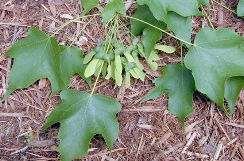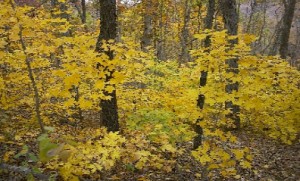Sugar Maple
Common Names: Sugar maple, hard maple, rock maple.
Native Range: Northeast and North central U.S. and South East and Central Canada.
Description: A medium to large tree, up to 80 feet tall, with a broad, round crown. Leaves are 3 to 6 inches long, triangular, 3- to 5-lobed, with edges sparsely and coarsely toothed. Petalless flowers are greenish-yellow on drooping stalks; fruits (called samaras) are reddish-brown, when ripe, in winged pairs.
Habitat: Sugar maple grows in a variety of soil types and conditions. It is found along stream banks and in moist to dry upland soils.
Ecological Impacts: Sugar maple can become invasive within upland forests. Maples sprout and grow rapidly and will shade out other tree, shrub and plant seedlings, thus reducing and even halting oak and hickory regeneration. Although seeds are not produced until trees are at least 22 years old, sugar maples are prolific reproducers, with the winged samaras carried up to 330 feet by wind. A Michigan study tallied 70,000 samaras per acre in the center of a clear-cut in a forest. Coupled with high average germination — up to 95% — mixed-wood forests can become dominated by maple growth.
Maple invasion of oak/hickory stands is most common following timbering, particularly on North slope areas, because the resulting open ground provides a perfect seedbed for maples. The speedy and lushly growing maple saplings quickly out-compete and shade out young oak and hickory seed stocks. Left alone, the former oak-hickory stand cannot reproduce itself and the mixed woodland becomes a maple forest.
Control and Management: Culling of maples is most effective by removal of trees where practicable, followed by chemical stump treatment. If trees cannot be safely removed or if a few dead snags for wildlife are desired, girdling, followed by chemical treatment of the cut surface is effective. Proper girdling of a tree is done by making two parallel cuts about 3 to 6 inches apart and about 1-inch deep all around the tree trunk. Trees may continue to leaf out and produce seed crops for up to two years after girdling, since sugar reserves remain within the tree. Stump and girdle-cut chemical treatment with glyphosate (Roundup) or triclopyr (Garlon) is effective in reducing the number of stump sprouts. Maple stump sprouting also will be retarded by fire in a controlled burn.
Comments are currently closed.


